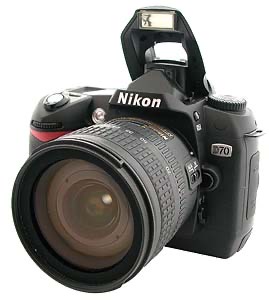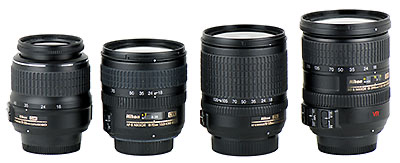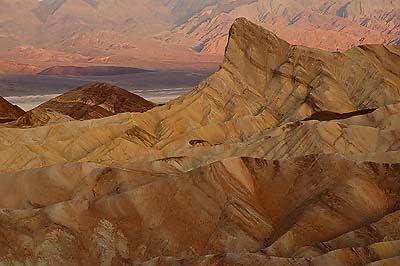This review originally appeared on bythom.com in September 2004. It has been updated and reformatted several times since then, including the most recent changes for the dslrbodies.com site.

What is It?
One of the surprises with the D70 announcement was that it could be purchased for US$300 more with a wide angle to telephoto zoom lens. Having a kit lens for consumer camera isn't new for Nikon, but a closer look at the specs showed this was an AF-S lens, an ED lens, had a moderately fast aperture at the telephoto end, and was a DX lens. Ver-ry inderesding, as they used on Laugh In.
The immediate question everyone asks is if an inexpensive lens that comes with the camera can be any good. I'll say you from scrolling down to the performance section: yes, beyond your expectations with one exception. And that's still pretty much true today if you've got a more modern Nikon DX DSLR than a D70. But before we get to the details, we need to go over some...well...details.
DX is often referred to as APS-C size, as it's very close to the frame size of that now mostly forgotten film type. To wit, the 35mm frame is about 36mm across the long axis, while the Nikon DX DSLRs are all about 24mm across the long axis. That means that any 35mm film or FX Nikkor lens has an image circle that is far bigger than is necessary on the DX DSLRs.
The DX series lenses are designed with an image circle more appropriate to the smaller sensor size of the DX lineup of cameras, which today comprise the D3xxx, D5xxx, D7xxx, and D500 models. The advantage of a DX lens is that it can be smaller and lighter than a lens of similar specifications that needs to cover the full 35mm or FX frame.
The first thing you notice about the 18-70mm DX lens is that it's very small. Indeed, a magician with a modest-sized hand could probably make it disappear before your very eyes just by palming it.

From left to right: the 17-55mm DX, the 12-24mm DX, and the 18-70mm DX (D70 kit lens). This should give you some idea of just how small the 18-70mm really is. And here are some of the 18-xx kit lenses Nikon has produced:

From left to right: the earliest 18-55mm, the 18-70mm for this review, the 18-105mm, and the 18-135mm.
The 18-70mm focal range gives you angle of views from ~19 to 66 degrees (horizontal) on a DSLR; it's effectively the same as using an 28-105mm lens on a 35mm body. For some users, that's a stay-on-camera range. There's no denying that this is a popular and much-asked-for focal length range. Indeed, even I find it interesting to walk around with this, the 10.5mm, and the 70-300mm on any Nikon DX camera—that makes for a very compact, light kit that covers a pretty incredible focal length range. Still, I would have loved for it to be 16-70mm—I miss that little bit extra at the wide end.
This lens features a two ring design; like many recent Nikkors, the zoom ring is the frontmost ring and the focusing ring is closer to the camera. Yuck. The lens does have a distance scale, but with no depth of field or infrared markings. You know, even if the lens manufacturers don't want to give us complete depth of field markings, the least they could do is mark the hyperfocal point at one useful focal length and aperture combination. In the case of the DX lenses, this is even more important, as standard 35mm depth of field charts won't help you; you need one designed specifically for the APS-sized sensors (copies of which are in my DSLR books, by the way). On the left side of the lens (from the back of the camera) is one button:
- Manual Focus button: In the M/A position the lens works as usual (autofocus with manual override). In the M position, the lens focuses only manually.
The HB-32 hood supplied with the lens is the bayonet type butterfly style. It can be reversed onto the lens for carrying, but it adds significant diameter to lens when you do so. It's pretty shallow, so doesn't present a lot of shading for the front element, but it's better than nothing. The lens itself uses 67mm filters, an odd size for Nikon and one that'll force almost everyone to buy a step-up ring of some sort (I use a 67-77mm step up, as my primary filter set is 77mm, but if you use the 70-300mm with this, you'll want to use 67mm filters and get a 62-67mm step up for the telephoto zoom).
You get AF-S focusing with this lens, and that'll take you down to 15 inches (.38m). The supplied lens cap is the new pinch-front type, and you get an HB-32 lens hood with it.
Overall, the lens is 90mm long and 13.5 ounces (390g). The original price of the lens was US$300 in the kit, and for awhile it was available separately for a higher price. You can only find this lens used, today.
Source of the reviewed lens: purchased
How's it Handle?
Handling is not the strong point of this lens.
The zoom ring is quite stiff and not at all fluid (as I've used my lens and moved it in and out of dry environments, it has a bit of a "catch" in the middle of the zoom range). The barrel extends an inch and a half at 70mm, so you're moving a far amount of plastic and glass in the zoom. The barrel also rotates slightly during zoom, which means that you may need to readjust filters. The focus ring is actually pretty decent (as are all AF-S focus rings), though it's thin and has nothing to distinguish it from the zoom ring other than position. Remember, the focus ring is not in a "normal" spot, and this takes some getting used to if you're coming from the standard 35mm Nikkor lenses.
Focal length changes slightly when you're shooting at close distances. As with most modern lenses, you should be focusing after framing, so I don't see this as a big deal.
The 18-70mm is small and light and balances on the front of a DX body very nicely. On bigger cameras, such as the D2h or D2x, the last of the large pro DX cameras, it just disappears. But either way, I felt comfortable. Even though it's small and relatively light, there's enough mass here to keep even the heavy bodies in balance.
How's it Perform?
I alluded to it before, so let's cut to the chase: on almost every performance parameter this is an excellent lens. The lone exception is vignetting.
Sharpness is excellent throughout the range on everything up through the 16mp cameras, with f/8 being the point of maximum sharpness on my sample pretty much across the entire focal length range. Even at f/3.5 (or 4.5 at the tele end) in the corners this lens remains an very good performer—much better than you'd expect for the price. I'd be more comfortable about using this lens wide open if it weren't for the vignetting, but if you have a modern (post D3) body or shoot NEF, you can safely ignore that comment, as the in-camera vignetting control handles this lens well, as do most converters that have lens profiles.
By f/5.6 there really aren't any big issues to worry about, though vignetting is still partially present. Chromatic aberration is well controlled, though not quite as good as the 17-55mm DX, especially at the wide end.
Images taken with the 18-70mm are sharp and contrasty. Even on the current 20/24mp DX cameras this lens still can be said to be a sharp performer, though you'll see more issues in the corners now.
Light falloff is, as mentioned, the big performance issue with this lens. It's present and obvious wide open (even at the telephoto end), and it extends to some degree for at least for two full stops. Whether this is a deal breaker for you is something you'll have to decide. I'm often filtering and post processing to darken corners of images, so I'm not as upset about this problem as some photographers. Especially so as I rarely shoot with a lens wide open. Stopped down to f/8 or beyond, vignetting really isn't an issue with this lens.
Put the 18-70mm on an FX body and it becomes obvious why the lens has light falloff: the image circle is small (hey, it's a DX lens, what did you expect?). There's no point at which this lens covers the full 35mm frame, unlike other DX zooms Nikon has produced. The image circle is smallest at 18mm, gets slightly bigger around 50mm, then starts getting smaller again. This exactly matches the vignetting performance I see. 50mm is about the best focal length in terms of light falloff, 18mm the worst, with 70mm somewhere in between. Note too, that light falloff is best at infinity focus and gets worse as the focus pulls in.
Here's a JPEG image taken at 70mm and f/8. The top version is a complete view of the frame, the bottom a 100% crop of part of the frame. Since you're going to ask, yes, the bottom has some sharpening in it (the camera was set to low), but as you can tell from the lack of halo, it's minimal.


In the 100% crop, you can actually see that the ISO 400 noise and stairstepping on edges due to the 6mp sensor size is competing with the detail captured. In short, for virtually any D70 user, you're going to find yourself bound by the contraints of the camera, not the lens. Looking critically at the image, I'm also focused just a bit behind where I'd normally want to be (the far valley wall is crisp, the nearest Zabriske "folds" are ever so slightly soft--I'd rather have that reversed). (And no, this isn't a D70 back focus issue--I simply goofed. This was a quick grab shot while I was working with workshop students. I think I was trying to demonstrate something at the time to someone.)
Distortion performance is very good. At both ends there's measurable distortion (barrel at the wide end, pincushion at the telephoto), but it's low in amount and not as obvious as we've seen in some other Nikkor designs. This isn't an architectural lens, but it's far from a fun-house lens.
Autofocus is very fast and mostly hunt-free. As I noted in my 17-55mm review, the primary focus speed difference between that lens and the 18-70mm comes in terms of the maximum aperture and in low light. In bright light, both a very sure and fast. In low light, especially at the telephoto end, the 18-70mm starts to lag, as it's just not letting as much light hit the autofocus sensors.
Flare performance is quite good except for direct into the sun. Unless light is hitting directly on the front element, I've not seen any visible contrast degradation. Unfortunately, the supplied butterfly type hood doesn't do a perfect job of keeping light from hitting the front element. If the light source is directly in the picture, things get a little wonkier, and you're likely to see contrast reduction if not ghosting. That's typical of virtually all modern zooms, though.
Bokeh is nothing exciting. It's a bit busy and onion-skinned.
Drawbacks
- Vignetting is back. We'd forgotten about it when we first moved to digital SLRs, as the older lenses had much larger image circles than necessary, but with a small DX lens that barely covers the APS-sized sensor, it's back.
- Variable aperture. The big issue is that at 70mm this is an f/4.5 lens, which means that autofocus in low light can be compromised slightly. Still, not a big issue, though a negative one.
- Build quality. Build quality doesn't exceed the price point.
Positives
- Excellent optics. Other than that vignetting, no flaws worth mentioning, actually. Considering the price, superb performance.
- The 28-105mm for the digital world. Yes, the mid-range zoom is back in full force. If that's what you want, this is the lens to get.
- Price/Performance winner. This is a far better lens than you'll ever expect for US$300. Far better. Good enough that it stays in my kit for when I want to go light.
Other notes about the lens:
- No Converters. While you can manage to mount the TC-14e and TC20e on the lens (why?), you can severely damage the lens if you do so. When you zoom out to wider focal lengths, the rear element of the lens would hit the front element of the converter. Not a big loss, though. Who uses converters on a midrange zoom?
- AF-S Limitations. The in-lens motor that makes this lens focus so swift doesn't work on all bodies. If you have a very older body, such as the N60 or Fujifilm S1, AF-S is not operative. Of course, since this is a DX lens, you're only likely to use it on a Nikon DSLR, and those all have no limitations with this lens.
- G Limitations. Because the lens has no aperture ring, if you were to use it on an older 35mm body such as the F4 or N90s, you'd need to put those cameras into Program or Shutter-priority exposure modes. Again, since this is a DX lens, that's not likely, especially since this lens doesn't have an image circle that covers the full frame.
Recommended (2004 to 2011)
